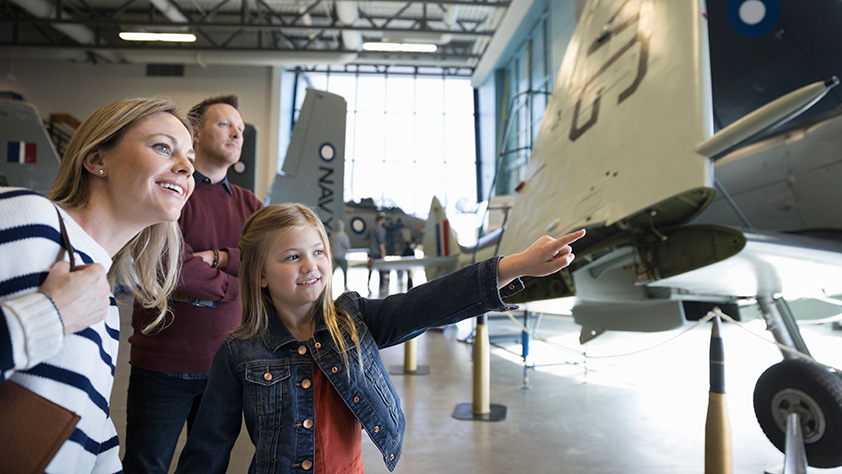A great museum can offer insight into life in the past, let you view famous works of art, or explain the inner workings of everything from a space shuttle to a dinosaur. Visiting a museum is part of the fun of traveling, whether it is a destination in itself (such as the Smithsonian Institution or the Metropolitan Museum of Art) or a lesser-known find (such as the John Michael Kohler Arts Center in Sheboygan, Wisconsin, or the Mütter Museum of medical history in Philadelphia).
Some museums, such as The British Museum in London and the 19 that make up the Smithsonian in Washington, D.C., are always free, while some others have a pay-what-you-wish policy that lets you set your budget.
But many museums do charge admission fees. Although the average U.S. museum admission fee is just $7, according to the U.S. Embassy, it’s not unusual for popular museums to charge $15 or $20 for adults. If you want to bring the whole family with you, that can really add up.
With a little advance planning and creativity, however, it’s possible to visit many museums—even those with hefty admission fees—for free, or almost free. Here’s how to do it:
Check for free days and times
If you live in or are traveling to some of the largest cities in the U.S., check to see which museums are always free or offer free admission on certain days of the week or month. You can do this by Googling “free museums” or “free museum admission days,” plus the city and state you want to visit. You can also check this list, which is not exhaustive, but includes one free museum per state. This list includes all the art museums in the U.S. by admission price and includes a free section at the bottom.
Some always-free museums include the J. Paul Getty Museum in Los Angeles, the North Carolina Museum of Natural Sciences in Raleigh, the Cincinnati Art Museum and the Frye Art Museum in Seattle.
Many more offer free admission on a particular day of the week or month. Portland Museum of Art in Portland, Maine, is free on Fridays, for example. Admission is free every Sunday at the Mississippi Civil Rights Museum in Jackson, and the National History Museum in Los Angeles is free every first Tuesday.
For other cities, check tourism sites for your destination, or look up the location on Tripsavvy. Information varies by city, but you’ll find articles on free museums and galleries in Minneapolis and Denver, for example.
Annual free museum days
There are several annual free museum days. Some are national or international, and some are local. While they may attract crowds, the savings are unbeatable.
Museum Day, brought to you by Smithsonian magazine, is a day of free admission to approximately 1,400 museums around the United States. The annual event occurs in September and allows free admission for two people with a Museum Day ticket downloaded from Smithsonian magazine’s Museum Day website.
International Museum Day is celebrated on May 18 every year. While it’s not a free museum day, many museums have special pricing or programming so it’s worth checking out museums you’re interested in visiting around that date to see if they might be planning any offers.
Finally, some cities plan their own museum days with free admission. For example, Austin, Texas, celebrates Austin Museum Day in September each year, where more than 20 museums in the city offer free admission plus special celebrations and events. Southern California has a Museum Free-for-All Day in January each year, with more than 40 participating museums.
Look for reciprocal admission programs
If you’re a member of a museum at home, that may qualify you for free admission to museums in many destinations you visit.
Through the Reciprocal Organization of Associated Museums, member organizations provide reciprocal admissions for members. It’s a bump up from the individual member rate for most museums, but it applies to the organization’s more than 200 member museums and arts organizations. If you travel a few times a year and visit museums, your investment could pay off quickly.
The rules are similar for the North American Reciprocal Museum Association, which includes more than 1,100 arts, cultural and historical institutions plus zoos and botanical gardens throughout the U.S. and Canada, as well as in Bermuda, Mexico and El Salvador.
Another organization that offers a reciprocal membership program is the Association of Science and Technology Centers. The ASTC Passport program includes more than 600 science centers around the world, including the Ontario Science Centre in Toronto and the California Science Center in Los Angeles. ASTC benefits are usually available to all members, regardless of level, but you’ll need to travel with your local membership card and photo ID, and note that the program does not include centers within 90 miles of your home.
Carry the right card
A happy side benefit of carrying a Bank of America® or Merrill Lynch® credit or debit card is that it qualifies you for free admission to about 225 museums through the Museums on Us® program. This benefit applies during the first full weekend of every month to member museums such as the de Young Museum in San Francisco, the Phoenix Art Museum and Detroit’s Motown Museum.
Look for special circumstances
During the weekend of the Chicago Marathon last October, the Art Institute of Chicago offered discounted admission to every runner who showed their finisher’s medal or bib at the ticket desk. If you’re traveling as part of a group tour or for a special event, read the fine print in your information packet to see if you’re eligible for special deals or discounts.
Additionally, certain museums offer free days on a designated holiday. For instance, admission to the National Underground Freedom Center in Cincinnati is free on Martin Luther King, Jr. Day.
Check to see if you fit into a certain group
Most museums offer free admission or special pricing for certain types of people. Discounted or free tickets for children, seniors, students, veterans and active military is common at many museums all year long, so be sure to ask and check websites (and bring the proper ID).
If you’re visiting museums in your hometown, check to see if they offer free or discounted admission to local residents. For instance, New York’s Met lets you decide what you’ll pay if you’re a resident of New York State or a student in New York, New Jersey or Connecticut. Detroit Institute of the Arts is always free for residents of Wayne, Oakland and Macomb counties. Be sure to bring appropriate proof of residency.
A collaboration among the National Endowment for the Arts, the Department of Defense and Blue Star Families resulted in the Blue Star Museums program. Running for more than a decade, the program makes admission free for active-duty military personnel and their families to more than 2,000 museums between Armed Forces Day and Labor Day. Participating museums for 2022 will be announced on the website in May, but the 2021 list spanned all 50 states, the District of Columbia, Puerto Rico and the U.S. Virgin Islands. Museums included the Whitney Museum of American Art in New York City, and the Lancaster Science Factory in Lancaster, Pennsylvania.
Look for discounts
If you can’t schedule your visit—or don’t meet the requirements—for free admission to the museums you want to visit, look into discount programs and packages that can reduce your costs.
For example, the new NEA Discount Tickets Program offers savings on admission tickets. For example, NEA members receive 25% off admission prices for the 9/11 Memorial Museum in New York City or the USS Midway Museum in San Diego.
CityPASS is available through the NEA Discount Ticket Program in 10 large cities in North America. Ticket books usually include five admissions to an area’s top attractions (including museums) and are good for nine consecutive days, giving you time to fit in other activities during your vacation.
Prices vary by city, but in Seattle, for example, your CityPASS purchased through the NEA Discount Ticket Program ($89.50 adults; $65.50 children) includes trips up the Space Needle and Seattle Aquarium, plus your choice of three more attractions, including the Woodland Park Zoo, the Museum of Pop Culture (MoPOP) and the Chihuly Garden and Glass.
Research in advance to find museum discounts and freebies
The one common denominator in all of these deals is that it pays to do some planning before you travel. Before you book a trip, go online and look up the museums in or near your destination. If they offer free admissions on certain days or weekends, decide if you can time your trip to take advantage of those perks.
Call ahead to verify the offers are still good, be sure to pack any necessary cards and your identification, and you can explore worlds of art, history or science wherever you go.












